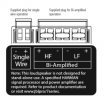I understand JBL don't actually come out and state this up front, but 708i is an
DSP-equalized and limited, passive-crossover speaker. It has a passive two-way crossover inside that can be used either with a single amplifier plus DSP or two amplifiers plus DSP. It
can be bi-amplified, but the only difference is the DSP EQ is now split between LF and HF, the amps are full-range and crossovers are all passive. That's how Amir is able to operate the speaker with a single amplifier, and he mentions the passive crossover in the review. Careful reading of JBLs literature confirms what I am writing to you.
In summary of what the speaker actually is: It's designed to use
one or two amplifiers per customer's choice. It has
passive crossovers only. It uses
DSP for shelving and notch filtering only.
So that you don't misinterpret my words, here is a picture of the DSP filters directly from London Architect EQ files for HF and LF:
View attachment 254307
There is a separate EQ file for single-wire, it is similar.
They could have added a DSP or passive notch at to the woofer at 2.6kHz. It's clear from the DSP and passive crossover that JBL have chosen to do nothing. Also, DSP notch becomes slightly interesting for single amp use, which is common.
My guess is that this harmonic distortion peak at ~900Hz is just too low in magnitude for JBL to worry about. The HD is stunningly low and free of artifacts, which maybe makes the peak at 900 Hz stick out.
This is not criticism. I love this speaker, and 708p too. These breakup modes seem to be a typical of underdamped wide band woofers used now, you end up with a breakup mode at the edge of the speaker's frequency response. You just need to deal with it. Here again is Amir's graph with the resonance frequency and the passive crossover clearly marked:
View attachment 254321
The rising impedance of the passive crossover already is going help damp these breakup modes. If you measured the bare driver with no crossover the resonance peak at 2.6kHz and the harmonic distortion peaks at 1/3 and 1/5 the resonance would be much more dramatic. You
could use heavily damped paper cone woofers from 50 years ago, but you wouldn't get this great result with such a high crossover point.

But so many woofers these days are of the same design and sound great. PuriFi are one example. I built a pair of DSP speakers with Seas W18 magnesium woofers which have a massive breakup mode, and tried both passive and DSP notches:
FFLOTSAM (Fabricated From LeftOver Things Studio Active Monitor) Active DSP speakers, for testing a few ideas I had some stuff lying around; a few random Baltic Birch-ply panels, some countertop material, a few cans of partially used brown spray paint, and some not-too clumpy spar varnish (that...

www.audiosciencereview.com
And Zaph has a nice set of measurements that show this cone breakup and harmonic distortion phenomena across multiple speakers:
JBL's solution to put the crossover far enough below the resonance is fine I think. I am eager to see part 2 of the review.


